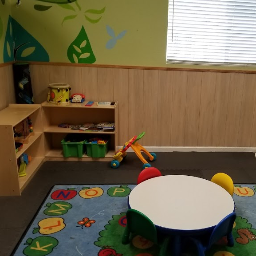Get Kids to Bed when Babysitting (8 Bedtime Secrets! + Video)


Written & Illustrated by
Matthew James Taylor
Kidsit Founder, General Manager

Babysitting Video by
Lydia Kutz
Babysitter, Infant Swimming Resources Instructor

Medically Reviewed by
Gina Maria Jansheski, MD, FAAP
Board-Certified Pediatrician, Medical Reviewer
Key Takeaways
- Stick to the bedtime routine: Consistency is key. Follow the child's usual bedtime routine to provide comfort and predictability.
- Create a calming environment: Dim the lights, reduce noise, and ensure the room is at a comfortable temperature to promote relaxation.
- Limit screen time before bed: Avoid electronic devices at least an hour before bedtime to help the child wind down.
- Address bedtime fears: Acknowledge and comfort the child if they express fears about bedtime.
- Be prepared for "one more thing" requests: Anticipate and gently manage repeated requests to prolong bedtime.
Bedtime can be one of the most challenging aspects of parenting, never mind babysitting. Some kids sleep on command; others will fight it like a ferocious Irish warrior.
If you’re out there looking for a simple solution like a “push-here-and-child-sleeps” button, there isn’t one. Every child is different, so there is no ultimate trick. However, in this guide, we’ll go over some approaches that really do work great when done correctly.
Top 10 ways to get kids to bed:
- Get kids to bed on time.
- Create a good environment for sleep.
- Offer the right snacks and drinks before bed.
- Maintain a consistent bedtime routine.
- Wind kids down before bed.
- Address any bedtime fears.
- Avoid screen time.
- Read a bedtime story.
- Prevent that “one more thing”.
- Avoid loud noises after bedtime.
Let's see why these work so well.
Lydia has been working in the childcare industry for 15 years, and owned a childcare agency in Florida, USA for 7 years. In this video she shares her tips for putting babies and kids to bed when babysitting.
1. Get Kids to Bed On Time
This is the single most important thing that you can do as a babysitter. Kids need a routine, regardless of how unruly they seem to be.
Bedtime is such a stressful situation and time if you and the kids are not prepared.
When it comes to babies you can't really prepare them, you can't tell them "bedtime's in an hour... bedtime's in 30 minutes... 5 minutes until bed", they don't get it. So, the number 1 important rule when it comes to putting babies to bed is sticking to their routine. So you need to ask mom and dad what is their routine because some like to be rocked, some like to be bounced, some like to be swayed, some like to be just left in the crib and for you to walk away. Some sleep with sound at night like white noise, some sleep with a night light, when it comes to babies routine is important.
Kiddos are also in routine but not the same as a baby. Kids don't always stick to routine, even though it might be structured it can be loose in what your doing. For example, a couple of my client's kids do outside time, they come in and get a bath, they read, and then they go to bed. But the activities that happen outside can be different, it can be swimming, bike riding, etc. Schedules can be flexible but the structure has to still go the same.
I give three bedtime warnings, I give an hour warning, a half hour warning, and a 5 minute warning so that they know that I'm serious, that it is going to be bedtime when I say it's bedtime. That way they get to prepare and they get to do those last minute 'Oh I need a drink', 'Oh I need to go to the bathroom', which I make sure they do all before they go to bed. I give them a drink, they go to the bathroom, then they go to bed, those are my last couple of steps because those excuses can go all night long.

Babysitter, Infant Swimming Resources Instructor
St Petersburg, Florida, United States
If kids go to bed late, it’ll actually be harder to put them to sleep. That’s because when the brain is overtired, it kicks into overdrive and releases cortisol (known as a stress hormone). This will keep the kids wide awake, and they’ll have a really hard time controlling their bodies and emotions. This isn’t a stage that you want to reach.
It’s also pretty likely that these challenges will extend into the next day as well. Kids thrive with structure, and bedtime is one of the most important elements within that structure.
One thing to keep in mind is that kids might need a little more time to get to bed when the parents are away. It doesn’t take much to throw kids off, and not having their parents around to take charge of the bedtime routine could cause a little anxiety.
In other words, don’t leave bedtime for the last minute. You need to be on the ball throughout the evening and keep one eye on the clock.
2. Create a Good Environment for Sleep
It’s pretty rare that a kid will just fall asleep without a ton of prep. Making the environment as conducive to good sleep as possible will make your job a lot easier.
Ambient Light
The sleeping area needs to be dark. Most kids will be uncomfortable when it’s pitch black, so leaving the door cracked open with the hallway light on might be a good solution, and may be what they usually do.
Some sitters bring their own night lights, just in case. They’re super cheap to buy at a thrift or dollar store, and they won’t take up much space in your sitter kit. And, if you find one that’s colorful or pretty, the kids might be totally enthralled with it.
Sounds
Obviously, the bedroom should be a quiet place, but there’s more to it than that. If the kids can hear things going on in the house while they’re supposed to be sleeping, there’s no way that they’ll stay in bed. They usually want to be where the action is.
In other words, don’t blast the TV, radio, or talk loudly on the phone when the kids are in bed. This is especially important when the door is cracked open. Even if the noises are soft, the kids will want to know what’s going on and sneak out of the room to find out.
Dress and Room Temperature
Getting the kids properly layered up for bed is important, too. How you dress them at night will depend on a lot of factors, including their age.
For babies, a wearable blanket (aka sleep sack) is generally considered to be safer than a loose blanket that could cover their faces and suffocate them. Babies may be sleeping too deeply to respond to a decrease in their oxygen. They also may not have the motor skills required to pull a blanket off if it’s obstructing their breathing.
For children up to about three or four years of age, regulating their body temperature at night is a tricky balance. If a toddler is too warm, there’s a much higher chance of night terrors or nightmares. A child that’s too cold will be constantly waking up.
Waking is especially challenging in this age group because these kids will usually call for help if their blanket falls off instead of just fixing it themselves. Generally speaking, the ideal solution for two- to four-year-olds is to wear layers for pajamas (including socks, if the kid wants them) so that they can continue sleeping no matter what the blanket does.
In terms of room temperature, it’s best if it’s a little lower at night. Most consider the sweet spot to be from 68–70℉ (20–21℃), although every kid is different.
Pro tip for babies: It’s generally understood that having a fan in the room to circulate air is safer. According to this study, SIDS (sudden infant death syndrome) was reduced 72% by this one factor alone.
3. Offer the Right Snacks and Drinks Before Bed
Do not give kids everything their heart desires before bed. If you do, you could be in for a total disaster. A full stomach before bed can make it nearly impossible for the kids to have a good sleep.
On the other hand, a light and healthy snack is totally fine (with parent’s approval.) Some actually help! You’ll get the best results from foods that combine protein and carbs. They form amino acids that act like tryptophan, which is the thing that makes everyone sleepy after a turkey dinner. There are lots of other foods that aid sleep in other ways.
Here’s a list of great, sleep-friendly light snacks:
- Whole-grain cereal with milk (no sugar)
- Toast
- Peanut butter
- Warm milk
- Yogurt
- Cheese
- Bananas
- Chicken or turkey
- Eggs
- Tuna
Just make sure that the kids do an extra good job of brushing their teeth after these snacks.
In reality, going to bed with an empty stomach can be even worse than going to bed full. As a babysitter, though, you’ll need to be careful with striking this balance. Lots of kids will feign hunger so that they can stay up later. This is especially common when the parents aren’t home. Don’t let them talk you into that.
Having a good supper in the evening will be enough for the majority of kids. If anything, a light snack will totally take care of the kid’s needs. It’s a good idea to take care of this way before bedtime so that it doesn’t throw off their routine. Ask them about an hour before bedtime if they would like a healthy snack (that the parents have approved of in your discussions earlier) and something to drink. And make sure to let them know it’s now or never.
4. Maintain a Consistent Bedtime Routine
As a babysitter, this is the single most important thing for you to get right. It’s a total make-or-break when it comes to sleeping success.
Why Consistency is Important
Kids need structure. Bedtime is when it’s absolutely the most critical. Because they won’t sleep with a snap of the fingers, they need to be mentally ready and wound down to be able to fall asleep and stay asleep.
The bedtime routine isn’t something that comes out of thin air; it’s a routine that’s already established in the home and that you need to follow religiously.
How to Do It
The best way for you, as a babysitter, to succeed with the bedtime routine is for you to follow how the parents do it as closely as possible. This means that you’ll need to spend some time going over it with them in detail before they leave. Walking tours of the house are a great opportunity to accomplish this.
Here are some questions to ask that will allow you to understand the family’s routine and how to keep the kids asleep:
- When and how does the bedtime routine start?
- When are screens turned off?
- Do you monitor liquids at night? If so, what are the rules, and what are they allowed to have?
- Should you get the kids to go to the bathroom during the night? When? (common approach for toddlers that are getting out of diapers)
- Is there an evening snack? When is it, and what do they usually eat? What if they want something later?
- Please place the following events in order:
- Brush teeth
- Bath time
- Story
- Pajamas
- Songs
- Anything else?
- Do you allow the kids to read or play quietly in bed? If so, how long?
- Do the kids pray at night? What’s the process?
- Do you use night lights or something else? Do they sleep with the door open?
- Do they prefer any white noise or music in the room?
- Do the children have a particular stuffed animal or blanket?
- Is there a specific procedure for dispelling bad thoughts or nightmares?
- When should the bedtime routine be completed?
- How is it handled if they get up because they want something or are scared?
Where it can Fail and How to Succeed Anyway
This all sounds great and wonderful that you can simply follow a checklist and have the kids put to bed like a total pro—until the parents tell you that they don’t have a bedtime routine.
Don’t worry! It’s pretty uncommon, but you can still apply the principles of a typical routine to help you out. It just might be a bit more of a challenge to get the kids to go along with it.
Here’s what I would recommend.
Do the bedtime routine listed above by filling in your own best-guess information, and you can still discuss this with the parents to make a plan. Then make sure that you thoroughly explain to the kids what’s going on. Give them a two-minute warning before the routine starts, and then explain the steps along the way. As you’re completing each step in the routine, remind them of what’s coming next and when.
Talk to the parents about how long it usually takes them to get to bed. Even if they say that the kids fall asleep right away, try to budget at least half an hour for the routine. If they say it can take a while, then budget an hour or more. For the longest time, my defiant 3-year-old needed a 3-hour routine!
This will all take some extra patience, but it’s definitely doable.
5. Learn How to Wind Kids Down Before Bed
There are a few practical suggestions for ways to calm the kids down before bedtime:
One of the best things you can do is to keep the atmosphere as relaxing as possible. Soft voices and a super soothing attitude will have a calming effect on the kids.
Another trick you might want to try is to play spa music. I like to pull up YouTube on my phone and search “spa music.” This works especially well if you have bluetooth speakers that you can connect to. Dim lights and keep it peaceful. Spa music is super effective for the winding down process.
One critical step is to make sure that the bedtime story is calm. For young children and toddlers, exciting adventure stories, while definitely a lot of fun, can be entirely counter-productive.
My daughter loves happy stories about beautiful, colorful, sparkly butterflies that live on rainbows and share candy with anyone that walks by. When she listens to these kinds of stories it gives her something happy to think about, and it can completely calm her down, so she's ready for bed.
For my boys, they prefer me to tell stories about diggers and dump trucks, simple problem-and-solution stories, or other things that are mildly interesting for their age group. The point is to keep the excitement at an absolute zero. At this point, the kids need to be ready to drop off to sleep.
Of course, boys and girls are all different so the kind of stories they enjoy will be based off of their individual interests. Try a few different subjects and see what they prefer.
6. Address any Bedtime Fears
This is a special concern when parents are away. A simple change in circumstances, especially around bedtime, can make the child’s mind race with uncertainties. They’ve learned to trust that their parents will take care of them, and you might be viewed as a bit of a question mark when it comes to your ability to scour the room for monsters and bugs.
One thing that’s really important is to avoid trying to diminish or dismiss their fears. Acknowledge them, talk about them briefly, and discuss solutions.
For example, for some younger kids, telling the story of the three little pigs at bedtime might make it difficult for them to relax and go to sleep because all they can think of might be the big bad wolf.
Whatever their fear is, acknowledge it. Try to equip them to deal with it confidently. This might mean giving them a special object or telling another calm, short story incorporating an example of another little child who learned how to make the problem go away. This can take a little creativity, but it’s a great way to calm their minds and help them get to sleep.
7. Be Aware of How the Day’s Activities Affect Bedtime
If the kids were overstimulated during the day, it could definitely make sleep more of a challenge.
For example, when babies learn to crawl, they’re known to have a few terrible nights of sleep. This is just because they can’t stop thinking about it; they’re wired and consumed with this newfound ability.
Older children are different, but there’s still a boundary that you don’t want to cross. If they uncover some sort of earth-shattering information during the day, it could be hard to stop thinking about it. This doesn’t refer to interesting information in response to the 5 million standard “why” questions you might get throughout the day. It’s more related to the types of revolutionary new concepts that blow their minds.
For example, try to avoid telling a very young girl which part of their body a baby comes out of. Leave that to the parents to explain.
Another thing that children require to be able to sleep properly is physical activity earlier in the day. If you spend several hours in the afternoon binge-watching movies with them instead of going outside to play, they’re going to have a hard time getting to bed. If the TV has been the real babysitter, then you’re in for it.
You don’t want to do any high-energy athletics in the hours before bedtime, but mid-afternoon is the perfect time to get them moving. Play outside, let them run around, have a dance party, go to the park, go swimming… all of these things will make for a more welcome bedtime.
8. Learn How to Put a Baby to Sleep
Putting a 5-month-old baby down for bed is totally different from getting a toddler or older child to sleep.
Here are a few very effective suggestions for getting a baby to sleep:
The bedtime routine needs to be significantly shorter for a young infant. It can consist of:
- A warm bath (not recommended for babies under 2 weeks of age; sponge bathe them)
- Changing into fresh pajamas
- Putting on some white noise
- Snuggling or rocking the baby. Ask the parents how the baby likes to be held and swayed before bed. Most will have a preference.
There are also a few bedtime elements that are quite age-specific.
0–3 months
While it’s not as common for a newborn to need a sitter, it does happen. Here’s what to do, beyond the generic list above:
Swaddle the baby if it’s recommended by the parents.
- Sounds that may be loud, steady, and annoying to us, like a hairdryer or static on a TV, are actually soothing for a baby. They probably bring back happy memories of being inside a warm tummy, with the sound of fluids and other body noises rushing by them.
- Observe the baby carefully and put it down before it fully falls asleep. Otherwise, the baby will develop a dependency on you to go back to sleep when it wakes up in the night.
- NEVER let a baby sleep on its tummy. It could suffocate. Instead, always place the baby on its back.
- Use a fan to help circulate the air in the room to make it easier for the baby to breathe.
- NEVER have loose blankets or any stuffed animals in the crib. Either use sleeping sacks or extra layers of pajamas.
- NEVER put a pillow under a baby’s head. It’s generally considered safe to use a small pillow for toddlers 1-1/2 years old and above.
If you want more information on a great method for calming babies and putting them to sleep, check out the 5 S’s by doctor Harvey Karp.
3–6 months
This is more commonly the age you might be sitting for. At this point, the baby should be a bit more mobile. Here are some tips:
- Don’t intervene too quickly. If you hear a few squeaks and squawks, wait a minute or two to see if the baby can work it out on its own. Fussing over the baby too quickly could just wake it up and realize, “Hey, there’s a human here! I want to be held!”
- Swaddling isn’t very common any longer with this age group, but “sleeping sacks” are fairly popular. Even still, try to be careful to tuck the blankets around the baby snugly.
- Again, try to nail the timing and get the baby in the crib just before it falls asleep.
6–12 months
This is where it can get much easier from a safety standpoint. At this age, babies are much more mobile. Regular blankets have replaced sleep sacks. Challenges with sleep are more commonly due to behavioral issues, failure to maintain a schedule and bedtime routine, teething, or a sign that the baby isn’t sleeping well.
How Much Sleep Do Kids Need?
New recommendations from the experts that came out in 2015 included the following sleep guidelines for children:
- 1–3 years old: They need about 11–14 hours of sleep per day. This includes nap time, which is usually once per day for this age group. Never underestimate a toddler’s need for a good nap!
- 3–6 years old: Around 10–13 hours of sleep is recommended. Younger children in this bracket might still require a short nap, but generally, this need is gone by age 6.
- 7–12 years old: usually 9–11 hours of sleep is ideal, although many kids get much less than that. A lack of sleep can result in behavioral issues or underperformance in school.
- 13–18 years old: generally 8–10 hours of sleep is required. For a lot of teens, 8 hours isn’t actually enough. Unfortunately, most teens report getting only 6–8 hours of sleep per day.
As you can see, a common trend is that only babies are getting enough sleep! This means putting all children to bed on time is essential. It will help them to behave and control their emotions, have improved attention and concentration, and have an overall more successful day.
Tips for a Successful Bedtime
Avoid Screen Time
Turn off the TV and any other electronics at least two hours before bedtime. According to one study, light from a screen can reduce the amount of melatonin that the body produces. This is the chemical that makes us sleepy.
Read a Bedtime Story

Reading books is an excellent way to wind children down and get them prepared for bed. Often kids used to a very regular bedtime routine that involves reading a story will start yawning right on cue.
If you have a stubborn child who refuses to sleep, then I highly recommend The Rabbit Who Wants to Fall Asleep by Carl-Johan Forssén Ehrlin. This book is amazing and can get almost any child to fall asleep. It even makes me sleepy when I read it!
Kidsit babysitting statistics
48.11% of babysitters love reading and storytelling with kids.
(Babysitting statistics calculated weekly from our live member data — Updated 11 Jan 2026)
Reduce Stress
Cortisol is a stress hormone that does a wonderful job of keeping kids wide awake. It is produced naturally when kids are overtired (giving you that “second wind.”) Once this happens, it’s ten times harder to put these little critters to sleep.
The best thing you can do is make sure that the bedtime routine happens on time and is followed to a T. This will naturally allow their little bodies to produce the chemicals needed just in time for a great sleep.
Offer a Security Object
Almost every kid has a “security object”— a blanket, teddy bear, doll, etc. Make sure that you know exactly which object belongs to each kid and have it at the ready. Having to search around for it before bedtime can be stressful for the kids.
Prevent that “One More Thing”
This is a classic yet devious tactic that nearly every kid maximizes. It can manifest in “I need a sip of water,” or “I’m hungry,” or “I’m scared” (with a smirk). Try to ward it off by anticipating all the most common requests and incorporating them into the bedtime routine.
Focus on Relaxation
Your objective should be relaxation, not sleep. Sleep will happen naturally when the kids feel totally at ease. If you’re constantly telling them to close their eyes and go to sleep, they might find it frustrating or stressful. They might feel pressured to do something that they’re not quite ready for.
Instead, just focus on helping them to feel as relaxed as possible.
Here’s something that I tried with my own kids: We called it the “calm thought.”
I’d ask them to close their eyes so we can play imagination. Then I’d tell them a little story. Something like this, speak very slowly with a gentle voice:
“Imagine we’re in a beautiful forest. There are butterflies all around. We have a picnic with (insert favorite food here - although this may make some kids hungry, so you might have to individualize.) There are rainbows in the sky sprinkling sparkly glitter all over the earth. A gentle breeze is flowing softly through the forest. (Swish your hand above their faces.) Can you feel the breeze? Now the sun is coming out, and we are beginning to feel the warmth on our skin. Do you feel the sun on your cheeks? It’s making us feel so warm and so sleepy… let’s relax in the sun and have sweet dreams about (insert things that the kids like here).”
Every child is different, so you might need to customize it a bit, but it really can work like a charm.
Just remember the main point: Focus on relaxation, do the routine so that they’re mentally prepared, and sleep will come naturally.
If you're faced with particularly stubborn children, read our essential guide: How to babysit difficult children to learn additional strategies for disarming tantrums and encouraging kids to do the right thing.
Have you lost sleep during an overnight babysitting job? Read our guide to surviving babysitting night shifts to learn the secrets for coping with sleepless nights.
Next:































